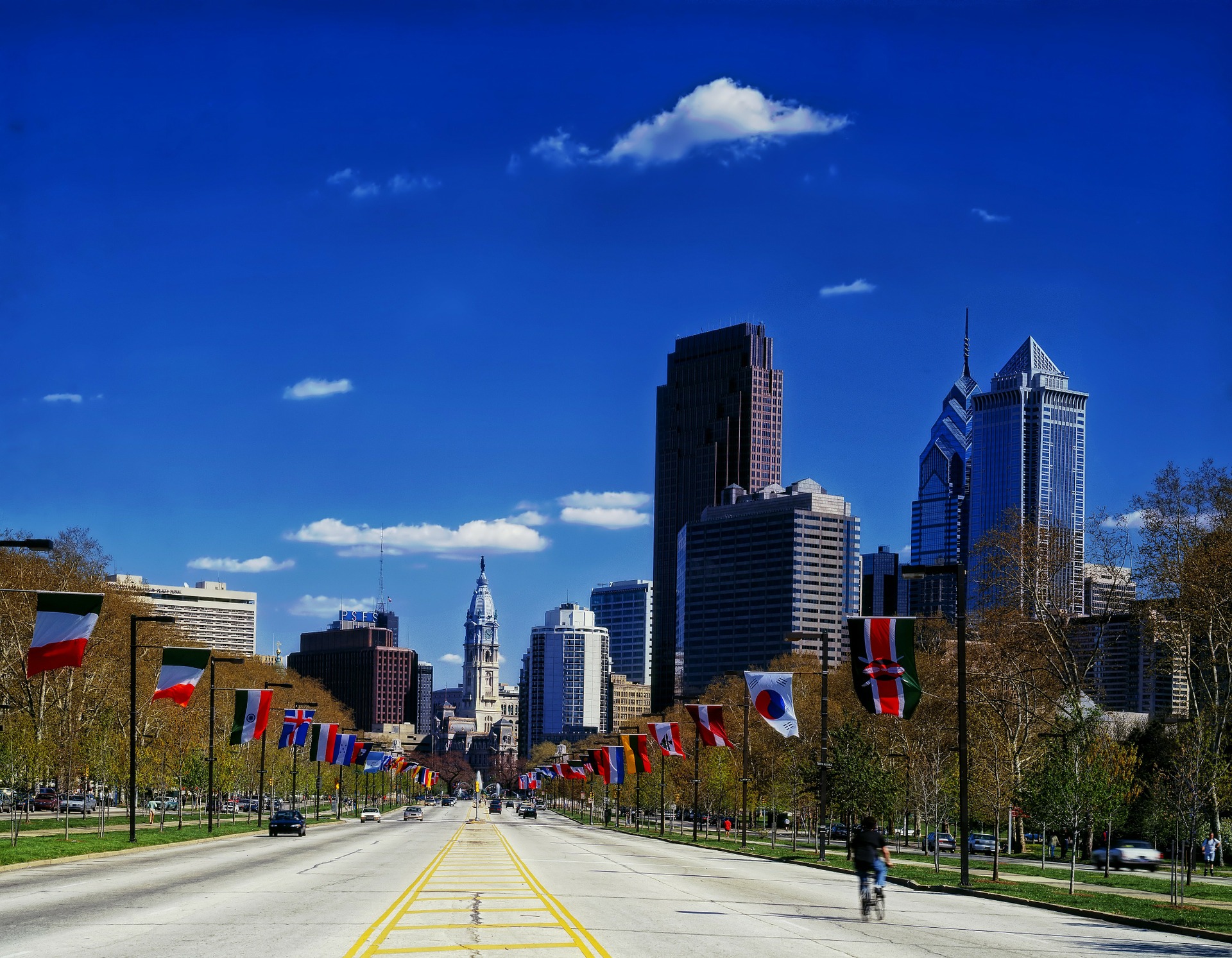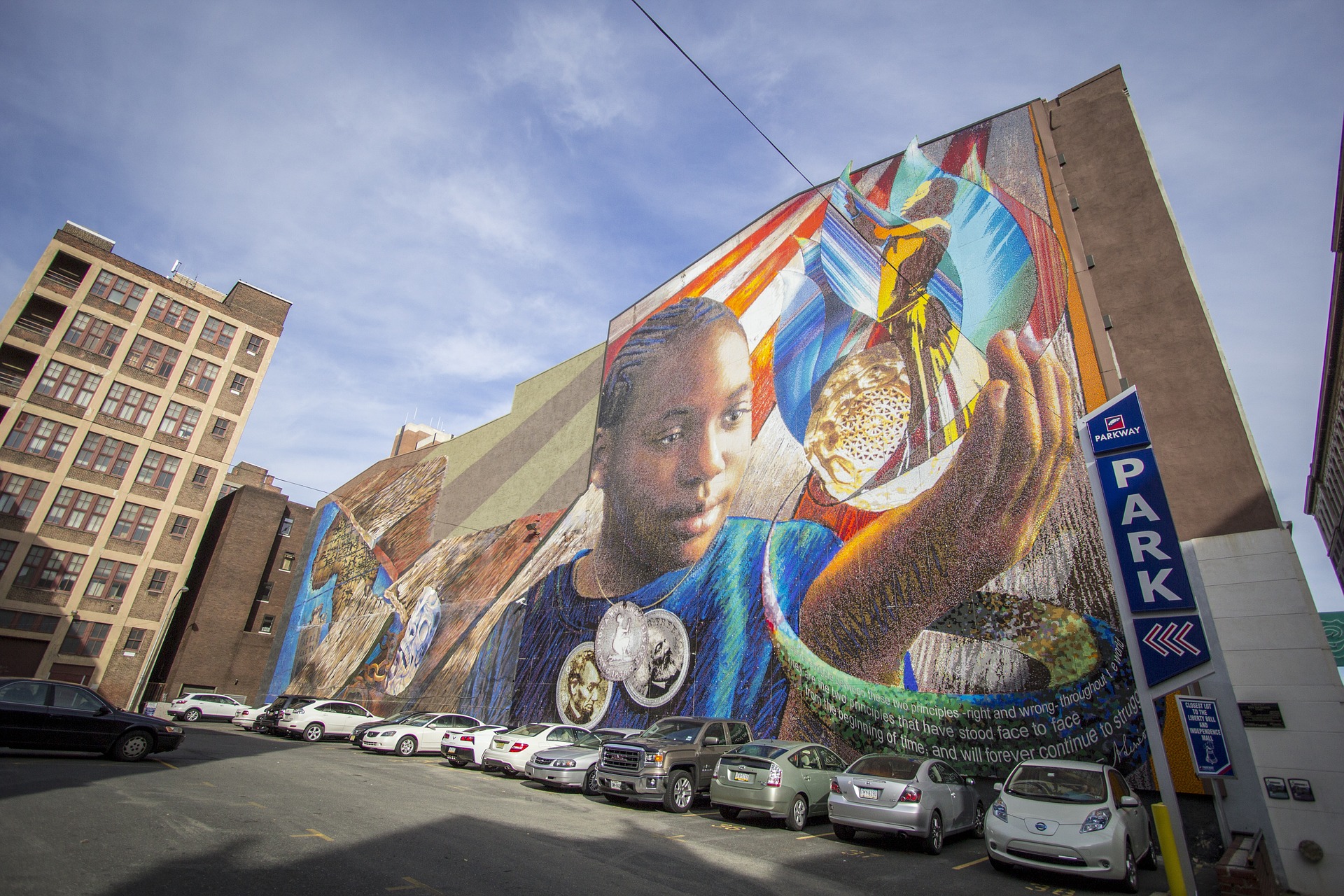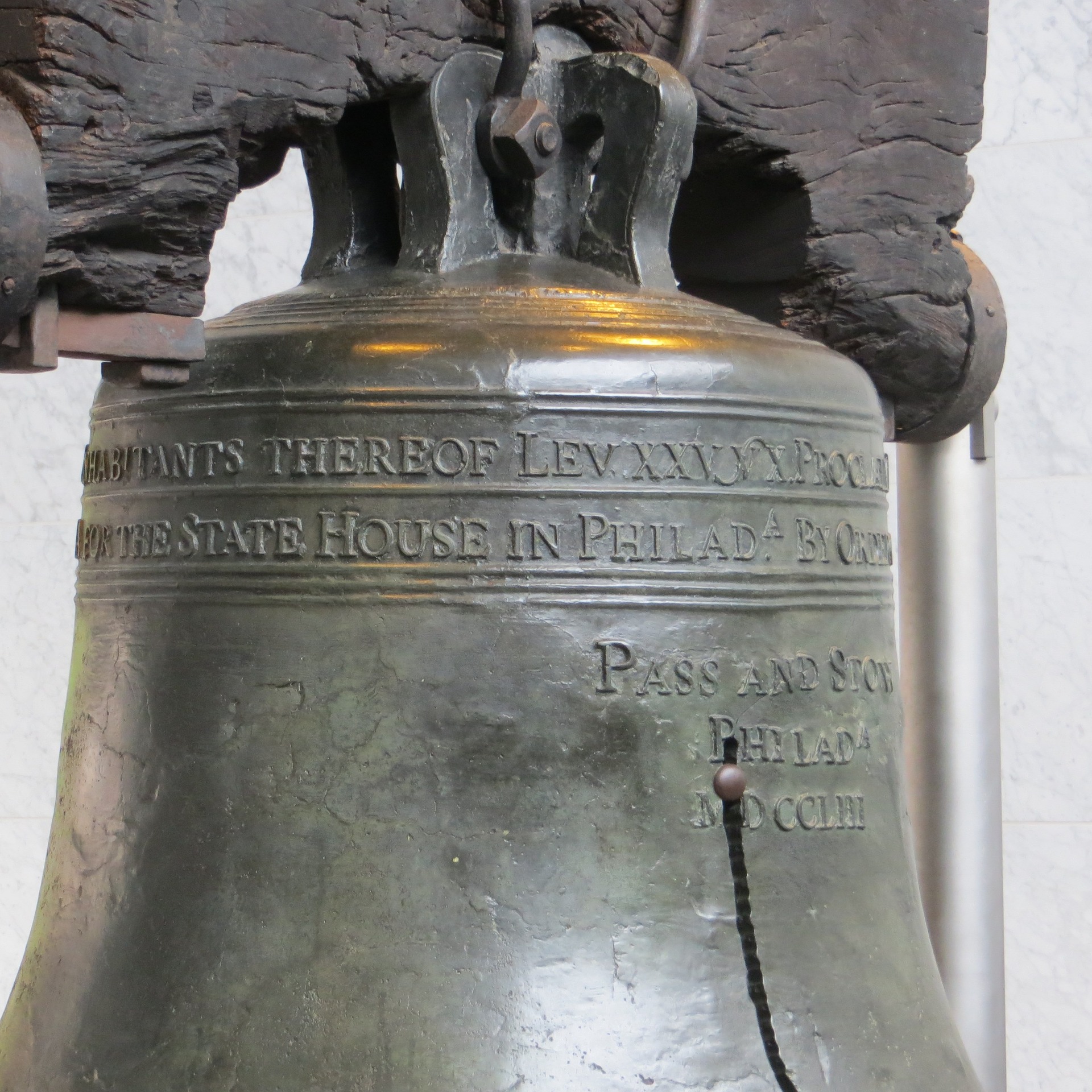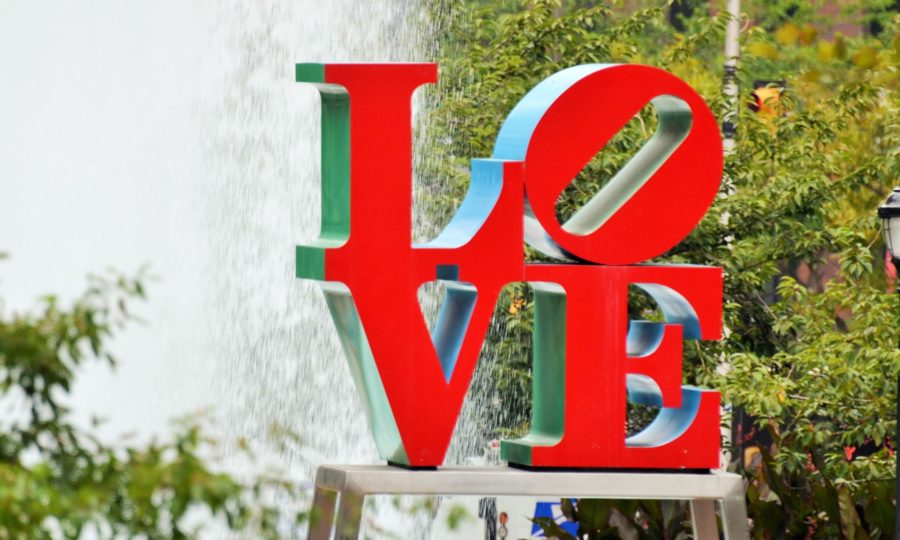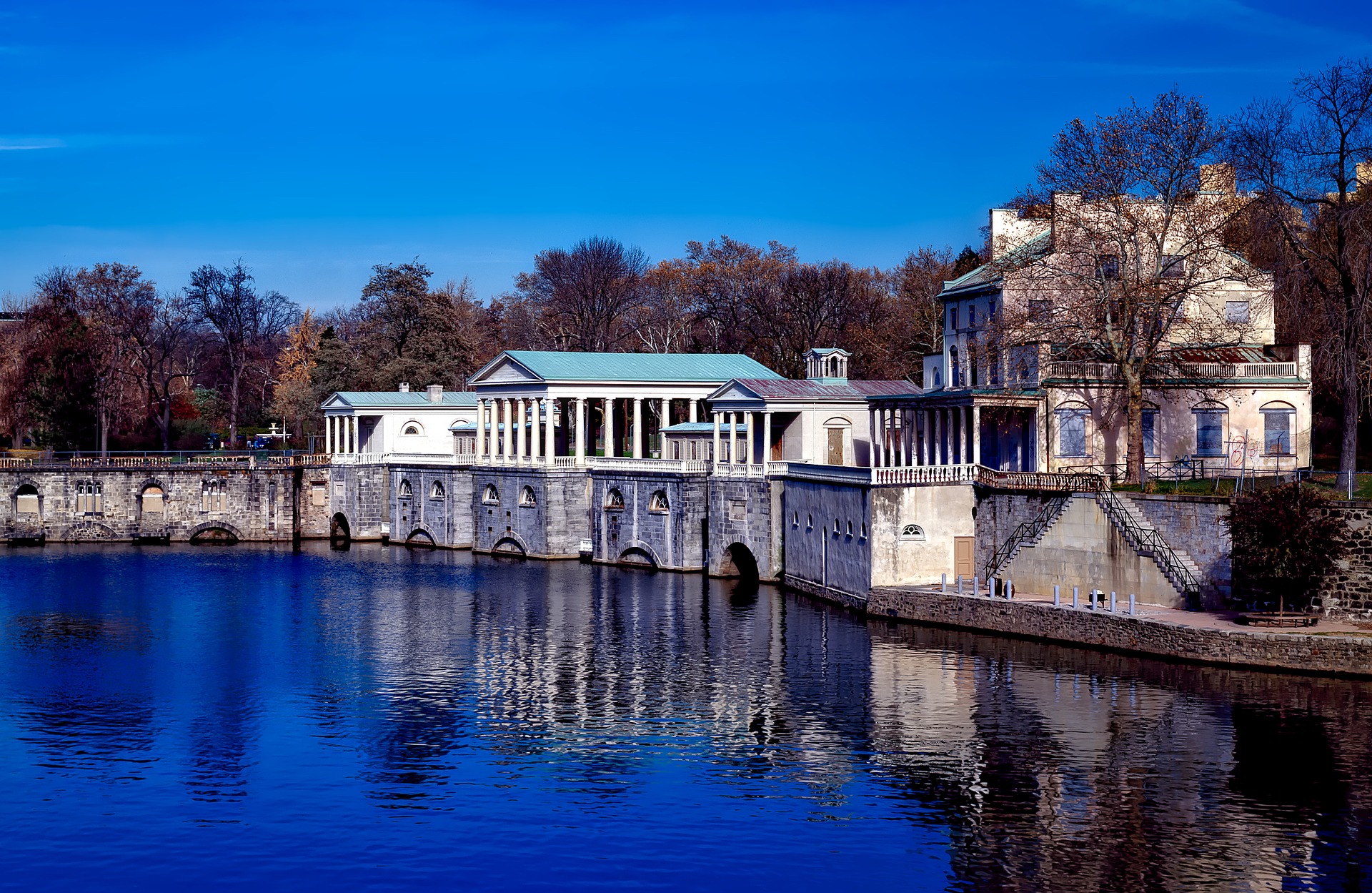Get Started.
Building your commentary is an ongoing process and learning experience. The following sections are starting points for learning the facts about sites commonly included in Scholastica itineraries. Add in stories and create a logical flow of information that matches your style.
Ben Franklin Museum
317 Chestnut Street
Explore Benjamin Franklin’s life and legacy through his character traits. The exhibit area is divided into five “rooms” with each room focusing on a particular trait: ardent and dutiful, ambitious and rebellious, motivated to improve, curious and full of wonder, and strategic and persuasive. There are videos, touch screen interactives, mechanical interactives, and artifacts in each “room.” An additional area called the “Library” presents a video with excerpts from Franklin’s Autobiography.
Betsy Ross House
239 Arch Street
The well-known and loved story of Betsy Ross sewing the first Stars & Stripes is tightly woven into the colorful fabric of America’s rich history. The Betsy Ross House, the birthplace of the American flag, is alive with the sights and sounds of the 18th century. Tour the house and then stay a while longer to learn more about Betsy and her exciting life and times through our interactive, historical programming.
Cheesesteak History
Cheesesteak History
The cheesesteak made its official debut in 1930. Pat Olivieri was a South Philadelphia hot dog vendor who one day decided to put some beef from the butcher on his grill. A taxicab driver noticed the alluring aroma and asked for his own steak sandwich.
The next day, as the story goes, rumor of the delicious lunch had spread, and cabbies around the city came to Olivieri demanding steak sandwiches. Soon after, Olivieri opened up a shop on 9th St and Passyunk Ave, Pat’s King of Steaks, to sell his new creation. Eventually, according to legend, he added cheese to the recipe.
Today, Pat’s grills are sizzling 24 hours a day, as are Geno’s, the rival shop across the street. For 40 years, the two shops have waged a friendly competition to win the title of best cheesesteak in town, with Geno’s founder, Joe Vento, claiming it was he, not Olivieri, who first added cheese to the cheesesteak.
How To Order A Cheesesteak
When ordering a cheesesteak at one of Philadelphia’s famous cheesesteak shops, the idea is to let the cashier know a.) that you would like a cheesesteak, b.) what type of cheese you want, and c.) whether or not you want fried onions. And you have to be as concise as possible while doing so.
Locals have become so adept at this practice that they basically have it down to three words: saying “one whiz with” to the person behind the counter means that you would like one cheesesteak [denoted by the “one”] with Cheez Whiz as your choice of cheese [denoted by the “whiz”] and with fried onions [denoted by the “with”]. Similarly, saying “one provolone without” would secure you a single cheesesteak [one] made with provolone cheese [provolone] and without fried onions [without]. Or saying “two American with” would get you two cheesesteaks both with American cheese and fried onions.
- Pat’s King of Steaks
The original home of the cheesesteak, Pat’s King of Steaks is still owned and operated by the Olivieri family. Pat’s claim to fame is that its founder, Pat Olivieri, invented the steak sandwich in 1930. Since then, Pat’s has grown from a little stand at the southern end of South Philadelphia’s Italian Market to one of the most famous cheesesteak shops in the world, albeit still in the same location (and still the only location). 9th Street & Passyunk Ave, (215) 468-1546. - Geno’s Steaks
It may be across the street from the oldest cheesesteak joint in town, but Geno’s Steaks is a formidable competitor going roll-for-roll with Pat’s for more than four decades. Like Pat’s, Geno’s is open 24 hours a day, seven days a week so you can visit whenever you get the urge. 1219 S. 9th St, (215) 389-0659. - Jim’s Steaks
Jim’s Steaks has multiple locations, but the classic smell of fried onions wafting down South Street makes that location the most memorable. Jim’s Steaks is South Street’s premier cheesesteak shop. The crowds can often mean an extra long wait before you actually get to taste one of Jim’s fine cheesesteak sandwiches, as the line at Jim’s often stretches out the front door and around the corner onto Fourth Street. 400 South Street, (267) 519-9253. - Campo’s DelI
Campo’s Deli is a great spot for anyone looking to sample some authentic Philadelphia flavor without traveling too far to get it. Conveniently located on Market Street in Old City, Campo’s is only three blocks from the Liberty Bell and the Independence Visitor Center. More famous for its creative menu of hoagies, Campo’s Deli cooks up a traditional cheesesteak, and they ship to other cities as well. 214 Market St, (btw 2nd & 3rd Sts) (215) 923-1000. - Sonny’s
Sonny’s has a great aesthetic — a mid-century vibe with all the necessary niceties to make your cheesesteak eating experience complete: friendly service, great product, and for those who like to stray away from the gristle and grime often associated with the sandwich, Sonny’s is perfectly clean, its lines never too long, and its clientele, tourists fresh off a visit from the historical sights nearby. 228 Market Street, (btw 2nd & 3rd Sts) 215-629-5760. - Steve’s Prince of Steaks
The original location of Steve’s is on Bustleton Ave in the Great NE section of the city, where over the past 30-PLUS years Steve’s has earned a sizable and devoted following of fans who swear the long, thin cheesesteaks that the “Prince” serves are the best in Philadelphia. At their location at 16th & Market in Center City which opened in 2013, Steve’s is making their famous cheesesteaks a lot more accessible, so expect many more visitors to become Steve’s devotees in the near future. And we encourage you to go taste one for yourself and find out why. 41 S. 16th St, (btw Market St & Chestnut St) (215) 972-6090
NOT ON MAP:
- John’s Roast Pork
A small shack amidst shopping plazas, John’s Roast Pork is perennially cited as one of the city’s top steak spots and it gets our nod for No. 1. Its secret weapon? A crusty seeded roll. John’s has long been a favorite of South Philadelphia dock workers and contractors, having opened in 1930, but in the last decade or so it has really gained mainstream recognition as one of the best purveyors of cheesesteaks in the City of Philadelphia, including a James Beard Award for America’s Classics. Also, don’t miss the namesake roast pork sandwich. 14 Snyder Avenue, (215) 463-1951. - Tony Luke’s
Located next to an I-95 underpass on an otherwise dull stretch of Oregon Ave in South Philadelphia, Tony Luke’s is another South Philadelphia institution. There’s no need for an inside here — you order and pick up your sandwich from the street side windows and feast upon your reward at the outdoor picnic-style tables. When ordering, don’t be offended if the staff seems a bit less than friendly; they take pride in giving a hard time to both regulars and first-timers. It’s part of Tony Luke’s lure. And note: Every sandwich at the award-winning Tony Luke’s is worth ordering, and they taste even better during a game at the nearby sports complex. Want a sneak peek of their cheesesteak? Take a mouth-watering look… 39 E. Oregon Ave. (215) 551-5725. - Dalessandro’s Steaks
If you’re a saavy enough cheesesteak aficionado, you will no doubt want to make the trek out to Roxborough, near Manayunk in Philadelphia’s northwestern ridge. There, along Henry Ave, you’ll find Dalessandro’s Steaks. Dalessandro’s has been serving delicious — if sinfully greasy — cheesesteaks from their corner locale for as long as anybody can remember. Legend has it that the grillmasters at Delassandro’s season their sizable flattoped grill with fat before adding the meat. 600 Wendover St, (215) 482-5407. - Shank’s Original
Visit Shank’s Original for a highly reputed cheesesteak and an old-school experience on the Delaware River Waterfront. The tradition of Shank’s dates back to 1962 when Shank’s and Evelyn’s (“Shank’s”) opened its doors to the Italian Market near 10th and Catherine streets. In 2009, Shank’s closed it’s original location and is now found on Pier 40 on the Delaware River. 901 S. Christopher Columbus Blvd., (215) 218-4000.
Christ Church
2nd & Market Sts
Christ Church, the birthplace of the American Episcopal Church, was founded in 1695 as a condition of William Penn’s Charter. Known as “The Nation’s Church,” it hosted members of the Continental Congress during the American Revolution and Presidents George Washington and John Adams in the first decade of the newly established Republic. Among early members were Benjamin and Deborah Franklin, Betsy Ross, John Penn (William Penn’s grandson), and signers of the Constitution and of the Declaration of Independence, including Robert Morris, Benjamin Rush, and Francis Hopkinson.
Christ Church Burial Ground
5th & Market Sts
Christ Church Burial Ground is one of America’s most unique Colonial and Revolution-era graveyards, with 1,400 markers on two beautiful acres right in the heart of historic Philadelphia. The Burial Ground is the final resting place of some of our most prominent leaders, including Benjamin Franklin and four other signers of the Declaration of Independence.
Eastern State Penitentiary
2027 Fairmont Ave
Eastern State Penitentiary was once the most famous and expensive prison in the world, but stands today in ruin, a haunting world of crumbling cellblocks and empty guard towers. Its vaulted, sky-lit cells once held many of America’s most notorious criminals, including “Slick Willie” Sutton and “Scarface” Al Capone. The Eastern State Penitentiary, opened in 1829, had central heating, running water and flush toilets before the White House.
Fairmont Park System
Philadelphia has the largest municipal park system in the world. The Fairmount Park System encompasses 8900 acres of public land in the city of Philadelphia. Included in this land are the two remaining squares, Washington Square and Rittenhouse Square, of the first five public squares zoned by William Penn at the founding of the city. These five squares were the first public parks in North America, and were dedicated in 1681 as part of Penn’s vision of a “Greene Country Towne”. Today the two remaining squares comprise only a tiny fraction of the Fairmount Park System, but are among the most heavily used by thousands of city dwellers.
Franklin Court
Market Street btw 3rd & 4th Sts
Franklin Court today contains a steel “ghost structure” outlining the spot where Benjamin Franklin’s house once stood. Underground is a museum with displays, interactive exhibits, and a 22-minute film entitled “The Real Ben Franklin”. Fronting Market Street are restorations of five buildings, three of which Franklin had built shortly after his return from France to be used as rental properties. These buildings contain an 18th century printing office, an architectural/archaeological exhibit, an operating post office and a postal museum.
Franklin Court was once the site of the handsome brick home of Benjamin Franklin, who lived there while serving in the Continental Congress, the Constitutional Convention and as President of Pennsylvania. The house, the only one Franklin ever owned, stood in an airy court off Market Street. Built 1763 -1765, it was a handsome structure 34 feet square, three stories high, with three rooms to a floor, a kitchen in the cellar, and chimneys on the side. By all accounts it was roomy and comfortable, filled with the fashionable touches of living. It was, he once said, “a good House contrived to my Mind”.
Franklin spent comparatively few years in his house. Political missions kept him abroad for almost 19 of the next 20 years. When he returned for the last time in 1785 after his brilliant tour as envoy to France, he was 80, home for good with time to devote to his home. He now built an addition on the west side of the house that expanded it by half. This gave him space for a library, two additional bedrooms, two garrets, and a place to store wood. “I hardly know how to justify building a Library at an age that will so soon oblige me to quit it”, he mused, ” but we are apt to forget that we are grown old, and Building is an amusement.” He also improved the grounds with grass plots, trees, flowering shrubs, and gravel walks.
After Franklin’s death in 1790, the house and property passed into the hands of descendants, who lived in it for a time before leasing it out to a succession of tenants. By 1812 there was little interest in the house, and it was torn down to make way for commercial development.
Franklin Institute Museum
222 N 20th Street
The Franklin Institute is a science museum and the center of science education and research in Philadelphia, Pennsylvania, US. It is named after the American scientist and statesman, Benjamin Franklin, and houses the Benjamin Franklin National Memorial. Founded in 1824, the Franklin Institute is one of the oldest centers of science education and development in the United States.
Independence Visitor Center
599 Market Street
The Visitor’s Center is located on America’s Most Historic Square Mile, across from the Liberty Bell and Independence Hall in Independence National Historical Park. The Center provides the millions of visitors who travel to Philadelphia with a FREE comprehensive orientation to the culture, history, shopping and dining options presented throughout the Greater Philadelphia region in an environment that is welcoming and convenient for travelers.
Museum of the American Revolution
101 S 3rd & Chestnut Sts
A Revolutionary Experience
From the early stirrings of unrest in Boston to the opening shots of the War of Independence, and from signing of the Declaration of Independence to the creation of the American Republic, the Museum’s core exhibition explores the ideas, events, and legacies of America’s revolutionary beginnings.
What to see:
Begin your visit in the Lenfest Meyer Theater, located on the first floor, with an orientation film, Revolution. This sweeping film explores the origins, experiences, and ongoing legacy of the American Revolution–setting the stage for your exploration of the main core exhibition.
This 15-minute film is shown throughout the day.
Head up the grand staircase to enter the core exhibition that explores the origins of the American Revolution, the fight for independence, and the on-going legacies of the Revolution.
Boston’s Liberty Tree
In one of the Museum’s captivating immersive environments, stand beneath the branches and lanterns of a life-size reproduction of the Boston Liberty Tree, a large elm tree where the first stirrings of revolt were discussed and debated. Engage with a gallery educator in the gallery, who will share stories and offer more information about the rise of “American Liberties.”
Battlefield Theater
The Battlefield Theater will put you on the front lines of the American Army as you are confronted by an all-out British infantry charge during the Battle of Brandywine. Before you enter, staff will teach you how to stand in ranks and move in formation as you prepare to experience the sights and sounds of the Revolutionary War.
Privateer Ship
Experience the Revolutionary War at sea by climbing aboard a life-size replica privateer ship. Guests will hear exciting true stories of individuals who served as privateers and participate in hands-on activities that were done by sailors themselves.
The Revolution’s Veterans
Come face-to-face with America’s first “greatest generation” through their photographs. Many veterans suffered after the war, as the new nation neglected their war heroes. The last known Revolutionary War veterans died shortly after the Civil War, still many had their photograph taken.
Washington’s War Tent
Conclude your exploration of the Museum and the story of the American Revolution in this moving and immersive film. Follow General George Washington’s Headquarters Tent’s remarkable journey from the Revolutionary War to the present.
This film plays every 20 minutes throughout the day.
Mütter Museum
College of Physicians, 19S 22nd St
The Mütter Museum is a medical museum located in the Center City area of Philadelphia, Pennsylvania. It contains a collection of medical oddities, anatomical and pathological specimens, wax models, and antique medical equipment.
National Constitution Center
525 Arch Street
The National Constitution Center is the world’s first museum dedicated to honoring and explaining the U.S. Constitution through over 100 interactive and multi-media exhibits, artifacts and film that bring the Constitution to life!
What to see:
- “FREEDOM RISING” IN THE SIDNEY KIMMEL THEATER
This stirring, 360-degree theatrical production, takes you on a journey from America’s founding to the present day. Supreme Court Justice Sandra Day O’Connor calls it “the best 17-minute civics lesson in the country.” We guarantee you’ll get goose bumps! - “SIGNERS’ HALL” I SIGNED THE CONSTITUTION
Add your name alongside the 39 Founding Fathers who signed the Constitution with this new interactive experience in Signers’ Hall. - CONSTITUTING LIBERTY: FROM THE DECLARATION TO THE BILL OF RIGHTS
View America’s founding documents up close in the new George H.W. Bush Gallery. One of the 12 surviving copies of the Bill of Rightsis displayed alongside a first edition Stone Engraving of the Declaration of Independenceand a rare copy of the first public printing of the U.S. Constitution. - CONSTITUTIONAL RIGHTS: ORIGINS AND TRAVELS INTERACTIVE
Explore the origins of the Bill of Rights and find out more about rights around the world. - AMERICAN NATIONAL TREE
Step up to this towering display of touch-screens and get to know 100 individuals who made an impact on our constitutional history. There are several famous faces, but you’ll discover many unsung American heroes too. - PRESIDENTIAL OATH OF OFFICE
Do you solemnly swear to preserve, protect and defend the Constitution? Be sworn in as the next president of the United States at this fun, interactive exhibit. - CIVIL WAR EXPERIENCE
Artifacts from this turbulent period in our nation’s history—including an original oil lamp from General Meade’s Gettysburg headquarters and an original Confederate canteen, lost in the heat of battle—are on display. - GRAND HALL OVERLOOK FLAGS
The museum’s Grand Hall Overlook features an American flag that has flown over every state capitol encircled by all of the state and territory flags in order of the date they entered the Union. - AMERICAN SPIRITS: THE RISE AND FALL OF PROHIBITION
Step back in time in American Spirits: The Rise and Fall of Prohibition, the critically acclaimed exhibit that brings the story of Prohibition vividly to life. - AMERICAN TREASURES: DOCUMENTING THE NATION’S FOUNDING
Explore American Treasures: Documenting the Nation’s Founding, an intimate look at the path the Framers took to create the U.S. Constitution and secure the Bill of Rights. - JOHN MARSHALL: PATRIOT, STATESMAN, CHIEF JUSTICE
Get to know Chief Justice John Marshall, a hero of the U.S. Constitution. Explore Marshall’s character, constitutional legacy, and the influential roles he played in the early Republic.
National Liberty Museum
321 Chestnut Street
The National Liberty Museum is dedicated to preserving America’s heritage of freedom by encouraging people to find their own place in the story of liberty. Visitors to the Museum enjoy an inspiring and entertaining experience, as they interact with incredible stories of heroes and a collection of contemporary art. Our core themes for young people and adults include leadership and good character; diversity and inclusion; peaceful conflict resolution; and civic engagement. Our primary art form is glass art, as it makes the point that freedom is as fragile as glass.
One Liberty Observation Deck
1650 Market at 16th St
One Liberty Observation Deck, also called Philly From The Top, is an 883 ft high observation deck located on the 57th floor of One Liberty Place in Center City, Philadelphia.
One Liberty Place
1650 Market at 16th St
One Liberty Place was the first and was completed in 1987. It stands 974.4 feet in height, and as of this writing is the tallest structure in the city. One Liberty handily broke the previous Philadelphia record held by City Hall at 548 feet. Since the completion of One Liberty several buildings have broken the City Hall record that had stood since 1894. Commerce Square 1 and 2, completed in late 1987 both rise to 572 feet. In 1989 Two Liberty Place capped-off at 848 feet. In 1990, Mellon Bank Center and the Blue Cross-Blue Shield Tower were completed at 792 and 700 feet, respectively. In 1991, Verizon Tower was completed peaking at 739 feet, completing the list of Philadelphia buildings taller than City Hall as of this writing.
Philadelphia City Hall
1401 John F Kennedy Blvd
Philadelphia City Hall is the tallest municipal building in the world. It stands 548 feet tall. City Hall is also the tallest occupied all-masonry building in the world.
Philadelphia Firsts
- Benjamin Franklin founded the nation’s first library, The Library Company of Philadelphia, in 1731. It served as the Library of Congress from the Revolutionary War until 1800.
- The Pennsylvania Academy of Fine Arts, which opened in 1805, is the country’s first art museum and art school.
- The nation’s first daily newspaper, “The Philadelphia Packet and Daily Advertiser”, was founded in Philadelphia in 1784 and had a six-year publication run.
- “The Philadelphia Tribune”, founded in 1884, is the oldest continuously published African American newspaper.
- Pennsylvania Hospital, founded by Benjamin Franklin and Dr. Thomas Bond in 1751, is America’s first hospital.
- And the University of Pennsylvania—the first U.S. university—opened the nation’s first medical school in 1765.
- Children’s Hospital of Philadelphia, founded in 1855, was the first hospital in the country devoted exclusively to kids.
- The Fox Chase Cancer Center was the nation’s first cancer hospital.
- The University of Pennsylvania also started the world’s first college-level business school, the Wharton School of Business, in 1881.
- Also, U. Penn’s Houston Hall became the first student union in the U.S. in 1896.
- The 27-ton Electronic Numerical Integrator And Computer (ENIAC) was the world’s first electronic computer. It was financed by the U.S. Army and developed in secret at the University of Pennsylvania’s Moore School of Electrical Engineering.
- The Philadelphia Zoo, which opened on July 1, 1874, is the nation’s first zoo. Today it houses more than 13,000 animals on 42 acres.
- The Academy of Music is the country’s first musical auditorium still in use for its original purpose. Construction was completed in 1857.
- Philly became the site of the first organized protest against slavery when the 1688 Germantown Quaker Petition Against Slavery was drafted.
- † It’s also the site of the first African American church, Mother Bethel A.M.E. Church, which was established in 1794.
- Bartram’s Garden is the oldest still-living botanical garden in all of North America.
- The first Thanksgiving Day Parade was held in Philly in 1920.
- In 1792, the Philadelphia Mint was the first Federal building built under the Constitution.
- The building that is now the Loews Philadelphia Hotel and 12th and Market Streets was the first international-style skyscraper and the country’s first completely air-conditioned building.
- The Philadelphia Naval Yard was the first naval shipyard in the U.S. It started somewhat unofficially in 1776 and became an official U.S. Navy shipyard in 1801
- In Philly in 1775, Johann Behrent built the first piano made in America.
- NASDAQ OMX PHLX, better known by its former name, The Philadelphia Stock Exchange, was the first stock exchange in America, founded in 1790.
- In 1937, the Philadelphia Orchestra became the first to appear in a film. Then, in 1948, it became the first orchestra to appear on national television. In 1973, it became the first American orchestra to tour in China.
- The iconicReading Terminal Market was founded in 1892, making it the oldest in the nation. The Italian Market is the oldest and largest outdoor market in the country.
- Philadelphia is the home of the country’s FIRST play (Thomas Godfrey’s Prince of Parthia, produced in 1767), FIRST grand opera (William Fry’s Leonora, from 1845), FIRST theater (the Walnut Street Theatre, built in 1809) and FIRST art museum and school (the Pennsylvania Academy of the Fine Arts). The Academy of Music is the OLDEST musical auditorium in the country still serving its original purpose.
- The Academy of Natural Sciences is the OLDEST natural history institution in the western hemisphere.
- The Philadelphia Eagles defeated the Cincinnati Reds (64-0) at Temple Stadium on November 7, 1934, when 10 touchdowns were made at the FIRST professional football game.
- In 1790, Philadelphia was declared the FIRST capital of the United States.
- Philadelphia has led the way in the art of celebrating: the FIRST birthday of our country (July 4th), the FIRST Thanksgiving Day Parade (1920), the FIRST city to adopt the Mother’s Day proposal (1908) and the FIRST and only city to enjoy the sounds of the Philadelphia Mummers, dating back to the late 1700’s!
- Wanamaker’s (now Lord and Taylor), located at Broad & Chestnut Streets, was the nation’s FIRST department store.
- Philadelphia’s Walnut Street Theatre, erected in 1809, is the first American theater and the oldest continually-operating theater in the English-speaking world. President Thomas Jefferson and the Marquis de Lafayette attended the theater’s first production in 1812.
- Philadelphia has a strong history of hosting party conventions. The city was home to the nation’s first Republican National Convention in 1856.
- The Philadelphia Philliesare the oldest continuous one-name, one-city professional sports team in American history. The baseball team played its first game on May 1, 1883.
- The first bank in the United States was created in Philadelphia in 1791
Philadelphia Museum of Art
2600 Ben Franklin Parkway
The Philadelphia Museum of Art is an art museum originally chartered in 1876 for the Centennial Exposition in Philadelphia. The main museum building was completed in 1928 on Fairmount, a hill located at the northwest end of the Benjamin Franklin Parkway at Eakins Oval. The museum administers collections containing over 240,000 objects including major holdings of European, American and Asian origin. The various classes of artwork include sculpture, paintings, prints, drawings, photographs, armor, and decorative arts. The museum is also one of the largest art museums in the world based on gallery space.
Walnut Street Theater
825 Walnut Street
The theater opened in 1809 as “The New Circus”, and was used for equestrian displays. A dome was soon added, making the structure the highest in Philadelphia at the time. In 1811 a stage was added for theatrical productions, and the theater was renamed “The Olympic”. In 1812 the first theatrical production was held there, entitled “The Rivals”. President Thomas Jefferson and the Marquis De Lafyette were in attendance. In 1820, the theater was renamed “The Walnut Street Theater”, and went back to “The Olympic” in 1822. In 1828 it was again renamed the “Walnut Street Theater”, putting the schizophrenia at last to rest.
